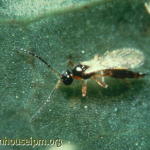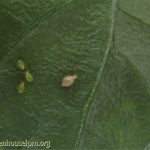Aphidius matricariae
Description
All Aphidius species are parasitoids of aphids. Aphidius matricariae is effective against Myzus species, such as Green Peach aphid.
Aphidius species are very small, non-stinging wasps with long, slender body and long antennae. Aphidius matricariae are black with brown legs, and approximately 2mm in length.
Biology
A single female Aphidius can lay over 300 eggs, mostly within the first week of adulthood. A female will lay an egg inside the body of an aphid. The egg hatches and begins to consume the aphid from the inside, eventually killing it. A dead, parasitized aphid is known as a “mummy”, and are tan-coloured with a papery-bronzed appearance. The fully developed parasitoid chews a hole in the outer casing of the mummy and emerges and begins searching for new aphids to parasitize. Development from egg to adult takes approximately 12 days at 25°C.
Recommendations for use
Aphidius species are very good at dispersing and searching for hosts, and are able to detect aphids even when they are at low densities. They are most effective when used preventatively.
Packaging
- Aphidius species are sold as mummies in bottles or blister packs with buckwheat hulls or vermiculite as a carrier material.
- Refer to the Quality Assurance of Biocontrol Products to determine the quality of the Aphelinus at receipt at the greenhouse.
- While they can be stored at 8-10°C, cold storage for more than 1-2 days after receipt may decrease their quality
Distribution techniques
- Sprinkle mummies directly on leaves, or in a thin layer in a distribution box nested within the plant canopy
- Distribute in greenhouse within 1 day of receipt
Introduction rates
- Preventative: 0.05-0.25/m2
- Curative: 0.5-2/m2
Environmental considerations
- Aphidius matricariae are not active below 10°C and have decreased fitness at temperatures above 28°C
Monitoring
- Parasitized aphids, aka “mummies”, look like aphids that have a bronzed, light brown, papery skin
- Mummies should appear in your crop around 2 weeks after initial release
Factors affecting
- Aphidius species are sensitive to many pesticides. Please consult the Quick Reference Guide to Registered Pesticides made by OMAFRA for compatibility information of products registered in Canada. Koppert and Biobest also have pesticide compatibility information listed on their websites.


